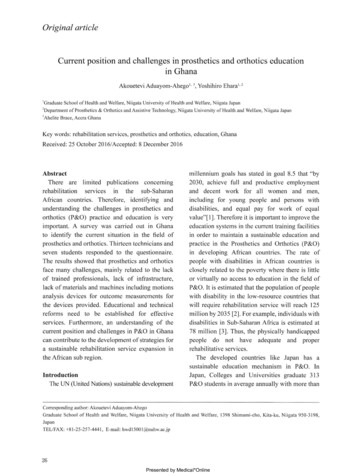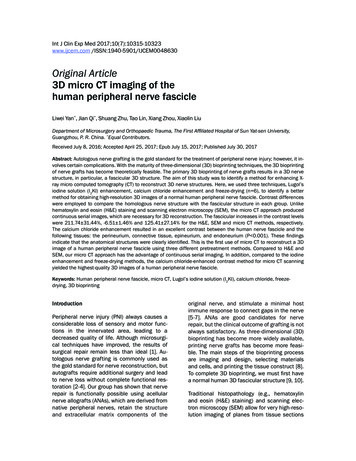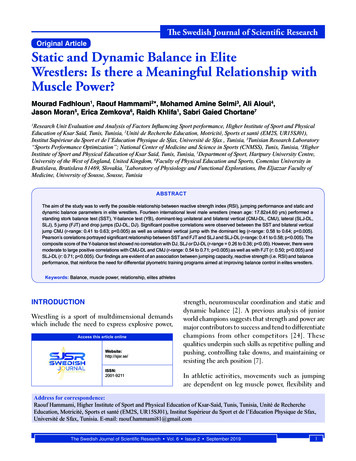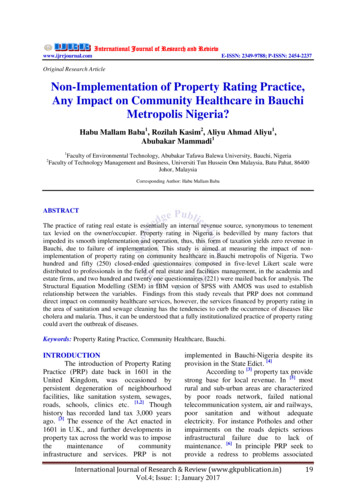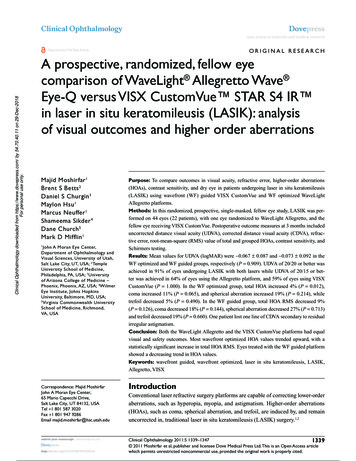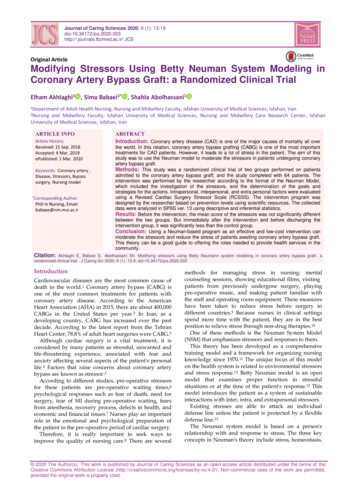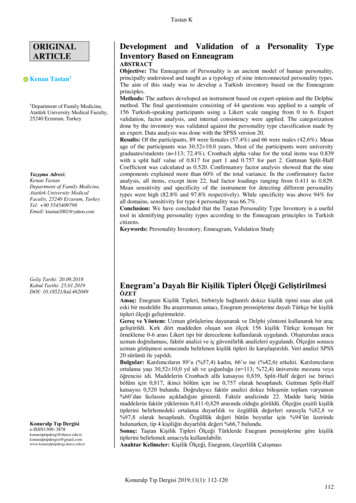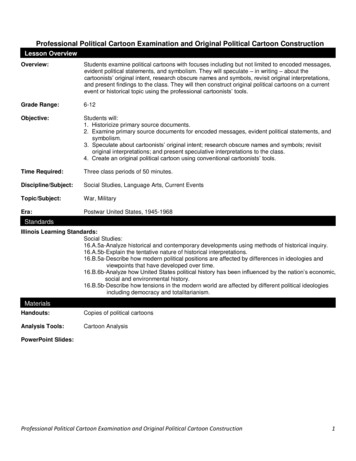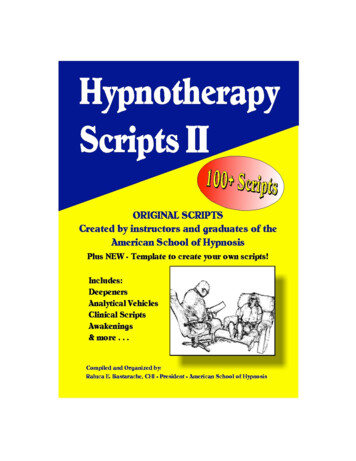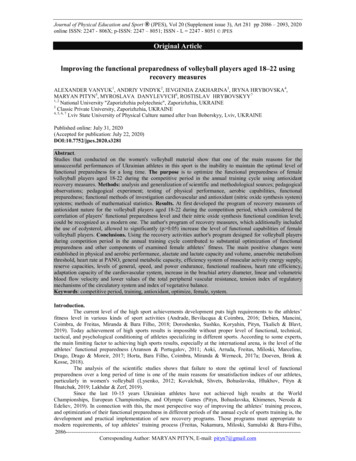
Transcription
Journal of Physical Education and Sport (JPES), Vol 20 (Supplement issue 3), Art 281 pp 2086 – 2093, 2020online ISSN: 2247 - 806X; p-ISSN: 2247 – 8051; ISSN - L 2247 - 8051 JPESOriginal ArticleImproving the functional preparedness of volleyball players aged 18–22 usingrecovery measuresALEXANDER VANYUK1, ANDRIY VINDYK2, IEVGENIIA ZAKHARINA3, IRYNA HRYBOVSKA4,MARYAN PITYN5, MYROSLAVA DANYLEVYCH6, ROSTISLAV HRYBOVSKYY71, 2National University "Zaporizhzhia polytechnic", Zaporizhzhia, UKRAINE3Classic Private University, Zaporizhzhia, UKRAINE4, 5, 6, 7Lviv State University of Physical Culture named after Ivan Boberskyy, Lviv, UKRAINEPublished online: July 31, 2020(Accepted for publication: July 22, 2020)DOI:10.7752/jpes.2020.s3281Abstract.Studies that conducted on the women's volleyball material show that one of the main reasons for theunsuccessful performances of Ukrainian athletes in this sport is the inability to maintain the optimal level offunctional preparedness for a long time. The purpose is to optimize the functional preparedness of femalevolleyball players aged 18-22 during the competitive period in the annual training cycle using antioxidantrecovery measures. Methods: analysis and generalization of scientific and methodological sources; pedagogicalobservations; pedagogical experiment; testing of physical performance, aerobic capabilities, functionalpreparedness; functional methods of investigation cardiovascular and antioxidant (nitric oxide synthesis system)systems; methods of mathematical statistics. Results. At first developed the program of recovery measures ofantioxidant nature for the volleyball players aged 18-22 during the competition period, which considered thecorrelation of players’ functional preparedness level and their nitric oxide synthesis functional condition level,could be recognized as a modern one. The author's program of recovery measures, which additionally includedthe use of ecdysterol, allowed to significantly (p 0.05) increase the level of functional capabilities of femalevolleyball players. Conclusions. Using the recovery activities author's program designed for volleyball playersduring competition period in the annual training cycle contributed to substantial optimization of functionalpreparedness and other components of examined female athletes’ fitness. The main positive changes wereestablished in physical and aerobic performance, alactate and lactate capacity and volume, anaerobic metabolismthreshold, heart rate at PANO, general metabolic capacity, efficiency system of muscular activity energy supply,reserve capacities, levels of general, speed, and power endurance, functional readiness, heart rate efficiency,adaptation capacity of the cardiovascular system, increase in the brachial artery diameter, linear and volumetricblood flow velocity and lower values of the total peripheral vascular resistance, tension index of regulatorymechanisms of the circulatory system and index of vegetative balance.Keywords: competitive period, training, antioxidant, optimize, female, system.Introduction.The current level of the high sport achievements development puts high requirements to the athletes’fitness level in various kinds of sport activities (Andrade, Bevilacqua & Coimbra, 2016; Debien, Mancini,Coimbra, de Freitas, Miranda & Bara Filho, 2018; Doroshenko, Sushko, Koryahin, Pityn, Tkalich & Blavt,2019). Today achievement of high sports results is impossible without proper level of functional, technical,tactical, and psychological conditioning of athletes specializing in different sports. According to some experts,the main limiting factor to achieving high sports results, especially at the international arena, is the level of theathletes’ functional preparedness (Aranson & Portugalov, 2011; Aoki, Arruda, Freitas, Miloski, Marcelino,Drago, Drago & Moreir, 2017; Horta, Bara Filho, Coimbra, Miranda & Werneck, 2017a; Doeven, Brink &Kosse, 2018).The analysis of the scientific studies shows that failure to store the optimal level of functionalpreparedness over a long period of time is one of the main reasons for unsatisfaction indices of our athletes,particularly in women's volleyball (Lysenko, 2012; Kovalchuk, Shvets, Bohuslavska, Hlukhov, Pityn &Hnatchuk, 2019; Lakhdar & Zerf, 2019).Since the last 10-15 years Ukrainian athletes have not achieved high results at the WorldChampionships, European Championships, and Olympic Games (Pityn, Bohuslavska, Khimenes, Neroda &Edeliev, 2019). In connection with this, the most perspective way of improving the athletes’ training process,and optimization of their functional preparedness in different periods of the annual cycle of sports training is, thedevelopment and practical implementation of new recovery programs. Those programs must appropriate tomodern requirements, of top athletes’ training process (Freitas, Nakamura, Miloski, Samulski & onding Author: MARYAN PITYN, E-mail: pityn7@gmail.com
ALEXANDER VANYUK, ANDRIY VINDYK, IEVGENIIA ZAKHARINA, IRYNA HRYBOVSKA,MARYAN PITYN, MYROSLAVA DANYLEVYCH, ROSTISLAV --------------------------------------2014; Pion, Fransen, Deprez, Segers, Vaeyens, Philippaerts & Lenoir, 2015; Ion-Silviu, Sorin, Paul, Tiberiu &Eugen, 2016; Sulyma, Bohuslavska, Furman, Galan, Doroshenko & Pityn, 2017; Hnatchuk, Lynets, Khimenes &Pityn, 2018).The sources on the problem indicate that the question of optimizing the athletes’ functionalpreparedness in various sports is investigated thoroughly (Vanyuk, 2013; Mielgo-Ayuso, Zourdos & CallejaGonzález, 2015; Kitamura, Pereira, Kobal, Abad, Finotti & Nakamura, 2017).However, the same sources confirmed that using traditional recovery means, particularly in women'svolleyball, can not fully ensure preservation of the long term optimal level of athletes’ functional readiness. Thisis due to the focusing on increasing only certain components of the athletes’ fitness. It is important that theimprovement of the system of recovering measures is especially relevant during the competitive period of theannual cycle of the athletes training, because of the largest physical and psychological loads (MielgoAyuso, Zourdos & Urdampilleta, 2017; Miroshnichenko, Salnykova, Bohuslavska, Pityn, Furman, Yakovliv &Semeryak, 2019).The current level of the problem of improving the athletes’ functional fitness in the annual cycle ofsports training has indicated the following content of scientific and methodological literature. It is mainlydevoted to the definition of functional fitness as the main criterion of general preparedness, discusses the featuresof improving the athletes’ functional fitness using various recovery measures, and also demonstrated thecharacteristics and substantiated physiological role of antioxidant systems of the organism (Rodriguez-Marroyo,Medina Carrillo, Garcia-Lopez, Morante, Villa & Foster, 2016; Nuccio, Barnes & Carter, 2017).A separate block presents a study of the effectiveness of professional volleyball players’ training, butthe vast majority of studies related to the training of men in volleyball (Horta, Bara Filho, Miranda, Coimbra &Werneck, 2017b; Hnatchuk et al., 2018).Thus, the development, experimental testing, and practical implementation into the training process offemale volleyball athletes, the author's program of recovery activities is actually. It must takes into account: thespecific features of this kind of sports games, the period of the annual cycle of training, the nature of thecorrelation dependence of the athletes’ functional readiness level and their physical fitness, and improves theefficiency of the training process.The purpose of the study is to optimize the functional preparedness of female volleyball players aged18-22 during the competitive period in the annual training cycle using antioxidant recovery measures.Materials and methods.Methods: analysis and generalization of scientific and methodological sources; pedagogicalobservations; pedagogical experiment; testing of physical performance, aerobic capabilities, functionalpreparedness; functional methods of investigation cardiovascular and antioxidant (nitric oxide synthesis system)systems; methods of mathematical statistics.The level of the female athletes’ physical capacity and aerobic capabilities was evaluated using aPWC170 submaximal cycle ergometer test.The determination of the volleyball players’ functional readiness level and its individual componentswas carried out using the computer program "SHVSM".The evaluation of cardiovascular functional conditions was performed with use of the variation andamplitude heart rate monitor methods and functional conditions of the antioxidant system (system of nitric oxidesynthesis) – with use the plethysmography method and tests with reactive hyperemia of brachial artery. Theresults of the study were processed with the standard methods of mathematical statistics.The research was conducted on the volleyball club "Orbita-University" basis of (Zaporizhzhya City, theNational league of the Ukrainian Volleyball Championship). In the terms of fixing experiment, which wasattended by 36 volleyball players aged 18-22, there were studied the peculiarities of the physical capacity,functional preparedness, cardiovascular antioxidant systems functional conditions and volleyball players duringthe competitive period in the annual training cycle. We have designed the program of recovery measures, thattaking into account the nature of athletes’ fitness changes and nature of the relationship of their functionalpreparedness and individual components of fitness.The forming experiment was performed in order to test our recovery measures program effectivenessduring the volleyball players’ competitive period and some practical recommendations were given. The formingexperiment enlisted 30 volleyball players who were divided by the control (16 girls) and experimental (14 girls)groups. The program of recovery measures during the competitive period of annual training cycle for the controlgroup included such recovery activities as a sauna, conditioning swimming, massage and self-massage, andpsycho-correction means. As for the volleyball players of the experimental group, in addition to these activities,the plant adaptogen ecdysterone, which is one of the leading stimulants of the body's antioxidant system, wasused.The basic principles of the authors’ program of recovery measures are the following: the appropriateness of the age-specific features and current fitness level of female athletes aged 18-22included in the program of recovery ---------------------------------2087JPES www.efsupit.ro
ALEXANDER VANYUK, ANDRIY VINDYK, IEVGENIIA ZAKHARINA, IRYNA HRYBOVSKA,MARYAN PITYN, MYROSLAVA DANYLEVYCH, ROSTISLAV -------------------------------------- taking in the account the peculiarities of sports activity of girls aged 18-22 on the basis of the commonphysiological characteristics of volleyball as one of the situational sports; the physiological orientation of the used recovery measures is their dominant effect on the physiologicalsystems of the body, which most provide the optimal level of functional preparedness (cardiovascular andantioxidant system (system of nitric oxide synthesis); the availability of the used recovery measures and the simplicity of their practical implementation; systematic use of all components of the comprehensive program of recovery activities; operational, current and step-by-step medical and biological control directed to monitoring theeffectiveness of the proposed recovery measures program.The experimental program of recovery activities during the competitive period for volleyball players aged18-22 in the experimental group included the following components: Sauna. Used once a week at the end of each training microcycle. The duration of the procedure was 1.52 hours. Conditioning swimming. Conditioning swimming activity (once every 2 weeks) was included in theprogram of recovery measures as a means of active recreation. Duration of the lesson - 45-60 minutes. Thepurpose of these workouts was to maintain the level of functional preparedness of female athletes and the currentlevel of functioning of their cardiovascular and respiratory systems. In the training process prevailed loads ofaerobic nature (75% of its total volume), 25% were taken by the mixed aerobic-anaerobic exercises. Monitoringthe loads was carried out according to the magnitude of heart rate - 120-140 beats min-1 for the loads of aerobicnature and 140-150 beats min-1 - for the aerobic-anaerobic exercises. Total metric area for 1 workout with theloads of aerobic nature was 350m, and with the loads of aerobic-anaerobic nature - 125 m. Massage and self-massage. The massage was performed by a doctor and a team’s massage therapist. Weused the following methods: stroking, rubbing, tingling superficial muscles of the body in combination with lightcalming movements. Self-massage of arms and legs was carried out by athletes independently with the help ofbrushes made of synthetic pile. The duration was 7-10 minutes daily. Psycho-correction. In our study, the program of psycho-correction included: auto-suggestion using theself-management techniques by G. M. Pokalov and autogenous training by I. M. Schulz. The following volumeof training was offered: duration - 30-40 minutes, frequency - once every 2 weeks. Further - one supportingtraining per month. Psycho-correction trainings were conducted by a group of specialists of the Faculty of SocialPedagogy and Psychology of Zapor
Drago, Drago & Moreir, 2017; Horta, Bara Filho, Coimbra, Miranda & Werneck, 2017a; Doeven, Brink & Kosse, 2018). The analysis of the scientific studies shows that failure to store the optimal level of functional preparedness over a long period of time is one of the main reasons for unsatisfaction indices of

